Arranging a place where you can always clean yourself up or take water treatments will require strength, technical knowledge and a certain amount of creativity. You need to buy furniture, choose plumbing fixtures for the bathroom.Also, install it so that using the room is convenient, and the process itself is a pleasure, not a headache.
The content of the article:
- Variety of plumbing fixtures
- Materials for the manufacture of plumbing fixtures
- How do plumbing and furniture go together?
- Optimal bathroom furniture
- What is bathroom furniture made of?
- We check the quality of furniture
- How to arrange bathroom furniture correctly
- Small room layout
- Layout of a small space taking into account the requirements for left-handed and right-handed people
- Layout of plumbing and furniture for a spacious room
- What location of plumbing fixtures in the bathroom will be optimal?
- How to install plumbing yourself
- Technical part
Variety of plumbing fixtures
In recent years, a huge number of accessories and equipment used to decorate the bathroom have appeared on the market. Moreover, models of very different designs - from utilitarian sets with simple washbasins, compacts, bathtubs to exclusive Spanish and Italian sanitary ware.
Motivation for purchasing bathroom furnishings and equipment:
- quality, convenient design of plumbing fixtures and furniture for storing things;
- price and durability of plumbing fixtures.
You need to choose based on consumer qualities, only then take into account price and design. A small overpayment for quality does not really matter. Purchasing high-quality plumbing fixtures will always justify the investment; in any case, the design will become outdated over time. So the main thing is quality and competent design.
Approximately 60-65% of products on the plumbing market are items made in China, using local raw materials. Maybe under a license from a development company from the European Union, but more often it’s simply copied from popular models. Moreover, the quality of copying furniture and plumbing fixtures for bathrooms can be so high that you can easily make a mistake. Especially if the idea of the appearance of the original is gleaned from the catalogue.
The remaining 25% comes from original plumbing fixtures of European quality and design (usually Italy, Spain, Germany). Cheaper, but original washbasins, toilets and shower cabins made in Turkey and Poland. Some companies offer exclusively domestic and Chinese models of plumbing fixtures of good design. Therefore, it makes sense to start the search with this group of manufacturers.
Baths
For any bathroom, the main accessory is plumbing for water procedures and washing. It may be small sitz bath 120 cm long for washing in a sitting position. Such plumbing fixtures are usually installed in small bathrooms combined with a toilet.
For full-size bathrooms, in modern apartments, bathtubs with a length of 150-180 cm are traditionally installed. In studio apartments, in bathhouse washrooms, in home saunas, and open-plan rooms, you can install a 200-210 cm bathtub.
In large rooms, in addition to or instead of the classic model, a triangular-shaped corner bathtub, a wooden barrel sauna or a mini-font in the hammam style can be installed. But in any case, before purchasing a specific model, you need to know the dimensions of all the plumbing fixtures in the bathroom.
Washbasins
The simplest sinks are installed next to the bathtub, shower stall, as well as cabinets, shelves, and any furniture for storing toiletries. This arrangement is dictated by the layout of sewer and water pipes inside the bathroom.
For larger rooms, it makes sense to buy ready-made furniture with a built-in washbasin, wardrobe, wall mirror and lamps. The price of such plumbing equipment is a little higher, but anyone can install it in the bathroom.
Shower cabins
In modern planning, the classic bathtub is increasingly being replaced by a shower. For a small bathroom, this is a simple shower tray with a curtain on a crossbar, a mixer with a hand-held shower head embedded in the wall cladding.
More advanced models are available in the form shower cabins. The closing door and heated tray make water procedures more comfortable. But there is a certain drawback - in both cases, the shower cabin takes up almost half of the bathroom space. The most compact corner models of cabins in the base projection have a size of 100x100 cm. At the same time, there is not much free space in the bathroom.
Modern shower cabin models are installed without a tray. Instead of a “trough”, a drain for draining dirty water cuts directly into the bathroom floor, under the floor tiles. The mixer with a flexible shower is closed in the wall, and instead of a cabin, a sliding door made of glass or transparent plastic is installed.
Materials for the manufacture of plumbing fixtures
Commonly used plumbing faience and acrylic. Most plumbing fixtures are made by casting and firing earthenware.At least all the toilets, bidets and washbasins are of good quality.
Medium and high price level cisterns for bathrooms and toilets are also cast from earthenware. Inexpensive items are made of impact-resistant plastic. Usually PVC.
The composition of faience and manufacturing technology are much more complex, requiring the preparation of raw materials and high temperatures during firing. A sign of high-quality plumbing fixtures is considered to be a uniform, subtle gloss due to the applied glazed coating. If you compare it with acrylic gloss, then earthenware is easy to distinguish - the reflection is slightly dull and slightly translucent in the light. This is because the glaze is transparent. Acrylic sheen is easily recognized by its unnaturally bright polished sheen.
Acrylic is often used to cast sanitary ware for budget-class toilets and bathrooms. This could be an inexpensive washbasin, a cabinet top, a tray, or individual parts of a shower stall. Most acrylic is used in the manufacture of plastic bathtubs. Acrylic-lined fiberglass castings account for nearly half of bathtub sales of all sizes and designs.
Bathroom furniture is made mainly from PVC, acrylic and painted polycarbonate.Most shower cabins are assembled from transparent monolithic polycarbonate, which in appearance is almost indistinguishable from mineral glass.
Shelves, wall cabinets, and mirror hangers are made of anodized aluminum. He is not afraid of a long stay in the humid atmosphere of the bathroom.
Front panels of cabinets and shelves are usually made of laminated MDF, OSB, mineral glass with a thickness of 6-7 mm. Thanks to the high stability of glass, shelves, doors, and mirrors do not lose their perfectly flat surface throughout their entire service life. In a bathroom, plastic furniture, even those made from expensive acrylic, often become deformed, shelves sag and lose their appearance.
How do plumbing and furniture go together?
In addition to a washbasin, bathtub or shower cabin for the bathroom, you will additionally need a set of furniture. Of course, this is not the set that is bought for the living room or kitchen.
For the bathroom, furniture is selected according to the following criteria:
- Small object sizes.
- No parts or coatings susceptible to water or hot, humid air.
- The decorative color, pattern and texture are selected in accordance with the design of the plumbing fixtures and the style of the room.
The design of shelves, wall cabinets, the design of chairs, the size and height of the mirror hanging, cantilever stands, hangers and shelves - everything must correspond to the size of the bathroom. There is no point in storing excess furniture or non-essential items inside, if only because the storage conditions are not the best.
Optimal bathroom furniture
The basic principle of selection is that all purchased items must be practical to use, have a simple design and be combined with plumbing fixtures.If increased demands are placed on the design of the bathroom, then it is better to entrust the design of the room to a specialist.
In other cases, you can choose plumbing fixtures for the bathroom and toilet on your own.
The optimal set of furniture and sanitary ware:
- Bedside cabinet under the washbasin. Wide enough to temporarily lay out several bottles of shampoo, soap, and water treatment kit. In addition to the fact that the box successfully covers the bellows and sewer pipes, the cabinet has at least one drawer for storing toiletries.
- Central mirror above the washbasin. Usually bought for a bathroom with a shelf and one or a pair of lamps.
- Wall cabinet for storing toothbrushes, toothpaste, cosmetics. This may be a model with a mirror facade.
- A set of wall shelves for storing items and products for water procedures. Sponges, washcloths, pumice blocks, tools for hair care, nail trimming are stored in the bathroom on open shelves.
- Hanger for temporary storage of outerwear in the bathroom. You will need a separate closet for clean linen and towels.
- Electric wall dryer, waterproof box with electric bag machine and socket for turning on hair dryer, hair clipper.
- If small children or elderly people live in the house, then the bathroom will need a stool or stand.
Seating furniture should be backless, with an aluminum or wooden frame that is strong and stable enough to support the weight of an adult. The seating surface should be covered with soft, non-slip upholstery that is resistant to moisture. It is better not to buy furniture with a steel frame for the bathroom.
If the layout or decoration of the bathroom does not allow hanging wall cabinets, or they do not match the design of the plumbing, then they can easily be replaced with a corner furniture cabinet.
If there is a washing machine in the bathroom, then you will additionally need a separate cabinet or bedside table for isolated storage of accessories, washing powder and water softener. If the floor in the room is equipped with water heating, you will need a plastic shock-absorbing tray to reduce vibrations when the washing machine is operating.
What is bathroom furniture made of?
Basic materials for a modern bathroom:
- plastic;
- aluminum profile;
- sheet mineral glass;
- solid wood and PVC films;
- MDF board, OSB, in budget furniture sets there may be chipboard or fiberboard;
- monolithic polycarbonate;
- artificial decorative stone.
In the budget segment, cabinet furniture for bathrooms is made either by assembly from polyvinyl chloride panels, or by casting PVC, ABS, or polyamide. It is bought for small spaces or when combined with a bathroom. The main advantage of plastic furniture is considered to be easy maintenance and the fact that plastic does not absorb odors.
The second option is furniture made from “wood by-products” - MDF or OSB boards coated with melamine or PVC film. Thanks to the film coating, the walls are protected from moisture and condensation. You can choose furniture for the bathroom with a walnut, rosewood, cherry pattern, or limit yourself to a monochromatic option, usually in light shades.
Shelves and doors can be made of mineral glass or polycarbonate.Handles, decorative overlays, frame and suspension elements are usually made of aluminum profiles. Countertops, front surfaces of wall cabinets, and sometimes shelves can be made of artificial stone. Typically this is an acrylic or epoxy monolithic slab with a quartz filler.
In the segment of expensive bathroom furniture, interior items are usually made from heat-treated natural wood, walnut or oak. African oak, ebony or Canadian cedar are used in the decoration of saunas and baths. In this case, the wood is hot polished to a natural matte shine without the use of waxes, polishes or varnishes.
We check the quality of furniture
Defective products, defects or incorrect assembly are found in models of all price segments. The main problem with inspecting cabinetry is that most items will need to be assembled into a finished product before being installed in the bathroom. You will need to fold the body, attach hinges and doors, install shelves and hanging hinges. We pay attention to the quality of the hinges, the absence of chips in the coating, uniform coloring, and the absence of stains.
It is enough to check furniture made from solid natural wood for scratches and damage received during transportation. It is imperative to check the completeness and absence of broken pins on the ends of the wooden panels. The film must be glued to the furniture board evenly, without bubbles or stains.
Small products - shelves, frames, cabinets can be checked at the place of purchase. They are easy to unpack and inspect to determine whether there are cracks or irregularities in geometry.
Countertops are checked for scratches and varnish delamination on edges and seams.This is important, since water gets under the thick layer of acrylic through the joints on the ribs.
Glass shelves and doors should be sanded along the end surface, and not just covered with a decorative plastic trim. Sanding removes sharp edges, thereby eliminating the risk of cracks due to careless impact.
How to arrange bathroom furniture correctly
The arrangement of furniture and plumbing fixtures inside the bathroom traditionally begins with the largest items. Before you install the pencil case and hang the cabinets, you will need to choose a place for the bathtub or shower. The usual place for plumbing fixtures is at one of the side walls or in a corner, away from the ventilation window or forced supply and exhaust ventilation.
The next step is to choose a place for a washbasin or toilet, if the bathroom is combined with a toilet. And only after completing the layout of the plumbing can you choose a place for the furniture.
Usually, before installing a bathtub and washbasin, the largest furniture - cabinets and pencil cases - are assembled “roughly” and placed inside the bathroom in order to determine whether the objects will interfere with the plumbing.
Small room layout
For a small bathroom, especially if it is a scheme combined with a bathroom, furniture arrangement is carried out according to the following rules:
- It is better to place the washbasin in a cabinet with one or two drawers. Hanging or “tulip” installation can, in theory, provide a little extra space under the plumbing, but in practice it is almost impossible to use it in the bathroom.
- A mirror with a shelf or a wall cabinet for accessories is hung above the washbasin. When choosing the installation height, it is necessary to take into account the height of the residents.For the little ones you will have to get a podium-bench.
- Shelves or a cabinet for storing shampoos and washcloths are hung on the wall next to the front door. On the opposite side, a snake is usually installed - a towel dryer and a clothes hanger.
- Sanitary products for cleaning and washing plumbing fixtures are stored in the cabinet under the sink, or on the shelves behind the screen covering the space under the bathroom.
Layout of a small space taking into account the requirements for left-handed and right-handed people
It is advisable to choose the storage location for accessories and items taking into account the left-handedness/right-handedness of the residents. For example, small objects are always picked up with the dominant hand, large ones - with either hand, but most people prefer to open/close cabinet doors or push/pull out a drawer with a “working” hand.
Therefore, if such a problem exists, then it is best to place personal items, toothbrushes, soap, deodorants in two separate small cabinets hung on the wall, to the right and left of the central mirror. Each storage location will have its own lamp. Most designers do this when planning the interior of a bathroom. Two lamps are not so much a desire to make the design more symmetrical, but rather an urgent need to take into account the needs of residents.
In this situation, large items are placed on shelves, usually on one of the walls adjacent to the entrance door of the bathroom. You can put everything in a floor cabinet with a hinged door in the most accessible place.
Layout of plumbing and furniture for a spacious room
If there is enough free space in the bathroom after arranging the plumbing, you can experiment with planning the space for furniture.
It is recommended to install a cabinet above one or two washbasins on one of the side walls of the room, preferably at a distance of at least a meter from the ceiling ventilation hole. Otherwise, dust from the bathroom ventilation will constantly settle on the mirror, shelf and nearby plumbing fixtures. Under the ventilation window there is usually a washing machine, a cabinet with detergents or a basket for assembling clothes. You can put a decorative flower on a shelf or a lamp.
It is advisable to position the washbasin so that the window opening or entrance to the bathroom is to the right of the sink.
A bathtub or shower stall is traditionally moved to the far corner of the room; a towel dryer and a shelf for bath accessories should be located here. If the sewer pipes are embedded in the floor of the room, then the bathtub can be moved to the center of the room.
The floor in a large bathroom will need to be made with a drain slope and finished with good quality tiles. For example, lay porcelain tiles, but without polishing. Seal the seams with sealant.
The slope can be made double-sided so that water does not collect under furniture or plumbing fixtures, but in a secluded place, for example, near the entrance to the bathroom. Accordingly, furniture is purchased either on adjustable steel legs or hanging, the kind that is mounted on the walls.
It is known from practice that any bathroom with expensive furniture and plumbing experiences flooding with water once a year. Therefore, a thoughtful floor layout will help preserve furniture and some plumbing fixtures from the harmful effects of water.
What location of plumbing fixtures in the bathroom will be optimal?
There are many conflicting opinions about what the correct plumbing in a bathroom should be. There is no single approach. You can adhere to the basic principle - the design and location of plumbing should provide the maximum level of comfort.
Main sink with cabinet
Installing a washbasin in the countertop of a bathroom cabinet is considered one of the most successful solutions even for small rooms. Usually the sink is built into the body of the cabinet, replacing the countertop.
Cabinet width 60 cm, depth 50 cm, height 80-85 cm. The lower compartment can be used for all sorts of small things, which are always plentiful in any bathroom.
If the room is decorated with MDF furniture lined with wood-look film, then instead of a compact cabinet you can put a cabinet with several drawers.
The washbasin can be made of acrylic and completely occupy the space of the countertop. This is convenient, since the acrylic coating has high hardness and durability. The white color of the sanitary ware goes perfectly with the dark finish of the facade of the cabinets or drawers.
For small bathrooms, you can choose a compact cabinet option. In such models, plumbing fixtures are installed on top of a wooden countertop.
There are certain advantages to this - there is free space under the sink, which can be used to store sanitary products or towels.
In addition to drawers and cabinets, console-mounted drawers and shelves are used to install a washbasin.
Furniture for plumbing fixtures is often made individually. For example, you can make a console-mounted cabinet, on the countertop of which there will be enough space for washing utensils, cosmetics and even flowers.
Washbasin with mirror
Usually, for brushing your teeth or washing your face, one small mirror suspended at a height of 130-150 cm is enough. In conditions of high humidity in the bathroom, it is not possible to use massive wooden frames or try to “cut” mirror glass into the furniture body, as is often done for bedrooms and living rooms headsets.
The maximum that can be done is to install the mirror in a plastic frame with an extended lower edge. It can be used as a shelf for cosmetics.
Or install a couple of decorative glass shelves on a mirror surface.
In the bathroom, the mirror must be equipped with one or two backlights. It's comfortable. The low power of the lamp is enough to illuminate plumbing fixtures, while the warm, dim light does not blind the eyes.
For children you will need to hang a separate mirror, the same shape as for adults, but smaller in size.
Two sinks or one
The use of two washbasins is only possible if the dimensions of the bathroom allow the installation of plumbing fixtures. Often the reason for installing a second sink is morning traffic jams in the room, when all family members need to clean up before leaving for work, school or kindergarten.
There are two options for installing plumbing - separate and common. In the first case, each sink is installed on its own cabinet with a set of accessories and a mirror.
If there are often guests in the house, then the number of washbasins in the bathroom has to be increased.
The second option involves installing two sinks or a double washbasin in one cabinet.
In the latter case, bathroom space is saved and the connection of plumbing to the water supply and sewer pipes is simplified.
Toilet
The location for installing this piece of plumbing has to be selected long and carefully. In the case of a small room combined with a toilet, the choice is small. The toilet is installed directly on the tee of the sewer riser. All other plumbing fixtures are placed in the free space of the bathroom.
For example, between a bathtub, a shower stall and a washbasin.
In combined bathrooms with a modern layout, the toilet can be placed almost anywhere in the room. But there are two important limitations that need to be taken into account:
- The drain from the toilet should be located 100-150 mm below the water seal of the bath or shower stall. To ensure a height difference, the tee under the toilet must be placed at a distance from the bellows of at least 120-150 cm.
- Supply and exhaust ventilation is installed above the toilet installation site. Exhaust fans are not placed above the rest of the plumbing to avoid drying out the water seal in the bellows.
In addition, they traditionally try to separate the space for plumbing fixtures with a decorative partition or place it in a niche or move it to a corner of the bathroom.
Bidet
Typically, plumbing fixtures are placed a short distance from the toilet. In small bathrooms, a bidet is installed only when a bath is abandoned in favor of a shower.
For rooms with a modern layout that are not combined with a toilet, the bidet is installed a short distance from the washbasin.
Bath or cabin
As a rule, the choice is determined by the preferences of the owners or the pace of life. A shower stall will take up no less space than a regular bath, so you won’t be able to save money. In addition, the presence of a huge glass box in the room has its disadvantages:
- Airing and ventilation of the space deteriorates. Often the cabin body causes the accumulation of dampness and condensation around the perimeter of the pan.
- The shower stall breaks down more often and repairs are more difficult.
- The space under the cabin pan must be regularly dried and treated with antiseptics.
The shower stall is convenient if you need to wash yourself quickly. In addition, many modern models for home bathrooms are equipped with steam generators and can operate in Turkish bath mode.
Otherwise, the shower cabin is inferior to a regular bath, both in terms of service life and level of comfort.
Freestanding bathtub
This type of plumbing differs from a classic bathtub in shape, size and installation method. A free-standing hot tub is made of fiberglass lined with acrylic, earthenware or cast iron. Plumbing fixtures are installed in the bathroom on a special podium or on steel supports.
The bath itself is located in an open space, usually at a short distance from a window opening or a special ventilation system. Some models of plumbing have built-in water heating, so water treatments can be taken without time restrictions.
Acrylic bathtubs are relatively inexpensive and do not require special preparation of the room. In terms of comfort they are not inferior to cast iron and ceramic ones and can be easily rearranged inside the bathroom. Cast iron bathtubs are more often purchased from the higher price segment.
The service life of such plumbing is 70 years or more.
Washing machine
Most often, a side-loading model is purchased for installation in the bathroom. Its dimensions are practically the same as those of top-loading machines, but the front location of the hatch simplifies the placement of the device among existing plumbing fixtures.
The washing machine is always placed under the bathroom wall - this is important to simplify the installation of hoses for draining dirty water and supplying clean water. The easiest way to hide the car is in furniture - a washbasin cabinet or a linen closet.
Sometimes the washing machine is placed directly under the sink. But such an arrangement will require a special cantilever mount and a bellows for draining water.
How to install plumbing yourself
Before placing furniture and plumbing fixtures, the bathroom needs to be prepared. Conduct communications, water and sewer pipes, lay wiring for wall lamps or a washing machine.
There are two ways to install plumbing:
- using standard fastening elements included with the plumbing fixtures;
- use homemade fasteners.
Washbasins, toilets, bidets, cabinets, cabinets, and washing machines are usually installed on a standard mount. The weight of the plumbing fixtures and the load are small, so the fasteners included in the kit by the manufacturer are sufficient.
Heavy cast iron and ceramic bathtubs inside the bathroom are often on a brick podium or on a welded frame.
Installation of plumbing begins with marking the walls and floor. Using the marked points, a fitting is performed to determine how correctly the drilling points are selected. They punch holes, drive plugs under the dowels and put the plumbing in place.
Technical part
For each type of plumbing fixture, you will need to select the installation height.This is the main parameter that is important to consider both for furniture - shelves, cabinets, and for a regular washbasin. This determines how comfortable visiting the bathroom will be for all family members.
For most types of sinks used for washing and washing hands, there are regulatory recommendations:
- SNiP 3.05.01-85, clause 3.15 - installation of plumbing in residential bathrooms.
- SNiP 11-64-80, clause 4.7 - for schoolchildren and preschoolers.
- GOST 24843-81, GOST 30493-2017 – requirements for the installation of steel sinks and washbasins.
The recommended installation height for ceramic washbasins is 800-850 mm for adults. For preschool children, the height should be no more than 700 mm. Therefore, in addition to the cabinet or cabinet under the sink, you will need to provide a pedestal or step. Moreover, this must be a permanent structure; no temporary shelters or benches for children are allowed.
Bath
The standard height of the bowl is 55 cm, 60 cm or 70 cm. To install a drainage device with a bellows, 15 cm is enough. If you use the floor option, you can reduce it to 5 cm. As a result, the bath can be installed at a level of up to 70 cm from the top edge of the floor . For some this is a lot, for others it will seem very low.
Lightweight acrylic hot tubs are placed on double supports. Each pair is a thick stamped profile with holes at the ends. The width of the crossbar profile is 6 cm, the length is 50-65 cm. Each crossbar must be secured with self-tapping screws to a wooden insert glued into the bottom of the bathtub.
Next, support studs with nuts are screwed into the holes at the ends of the profile. After this, the plumbing fixtures can be moved to the bathroom and the height of each support can be adjusted.Using a building level, set the drain slope of the housing so that the water runs down to the bellows.
It is important that after adjustment the weight of the acrylic body is distributed equally across all four studs. After assembling the drain, you can close the hole with a stopper, fill the bath with water and once again adjust the height of the supports. The gap between the wall and the body can be closed with a sponge rubber gasket, but only after finishing the bathroom.
If you plan to install a cast iron bathtub, then it is better to place it on a podium made of bricks or weld a frame from a square pipe.
Sink
Usually a washbasin or sink is purchased together with a cabinet and a mirror. To install the plumbing fixtures, you just need to assemble the furniture body, screw the legs, place it in the chosen place in the bathroom and insert the earthenware sink into the hole on the countertop. All that remains is to fix the mixer, connect the water and sewer drain.
Installing a sink on a bathroom wall is a little more complicated. First of all, you need to choose the height of the suspension. This can be done by simply trying on the plumbing fixtures against the bathroom wall according to your height, or using a table.
| Height, cm | 140 | 145 | 150 | 155 | 160 | 165 | 170 | 175 | 180 | 185 | 190 | 185 | 200 |
| Suspension height, cm | 85 | 90 | 90 | 95 | 95 | 100 | 100 | 105 | 110 | 110 | 115 | 120 | 125 |
Attaching a heavy ceramic washbasin directly to the tiles on the bathroom wall is only possible as a “tulip”. In other cases, for cantilever installation, a load-bearing metal panel is first placed in the wall, under the tiles. The embedded element is secured to the concrete with dowels.
After gluing the tiles, you need to drill holes, fix the plumbing, connect water and sewerage.
Toilet
In the same way, mounted plumbing fixtures such as a bidet or toilet are installed on the bathroom walls. On the one hand, this is convenient, as it makes it possible to save space.On the other hand, only a specialist can install a wall-mounted toilet, since the load is an order of magnitude higher than in the case of a washbasin. In addition, you will need to accurately pair the outlet of the toilet neck with the inlet pipe of the sewer riser.
You can install a floor-standing toilet yourself. The first thing to do is measure the dimensions of its neck and determine the height of the inlet pipe of the sewer tee.
It is best to measure along the bottom edge. If the error is no more than 5 mm, then the toilet can be brought into the bathroom, put on a transition corrugation and connected to the pipe. When moving plumbing fixtures, you need to determine its optimal position, in which the corrugation does not deform. It is clear that you need to take into account the dimensions of the drain tank; it protrudes beyond the body and may not fit into place if the distance to the wall is too small.
All that remains is to use a hammer drill to punch holes in the tiles or concrete of the bathroom floor, hammer in the plastic plugs and tighten the screws. Be sure to cover the fastener heads with plastic caps, otherwise in a year or two the slots will rust and it will be impossible to remove the plumbing fixtures.
It always takes a long time to select plumbing fixtures for a bathroom, try them on with the planned furniture, and repeatedly measure the dimensions of the room. A mistake in the placement of furniture or plumbing fixtures can be very costly.
Tell us about your experience in selecting and installing bathroom fixtures. Did any problems arise and how were they resolved? Save the article in your bookmarks so as not to lose it.






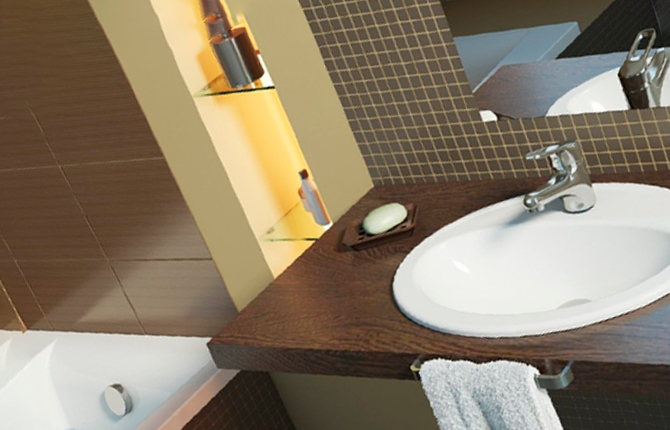

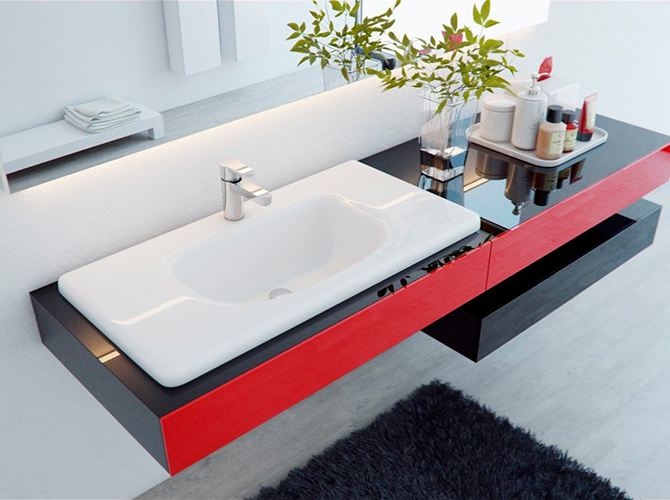
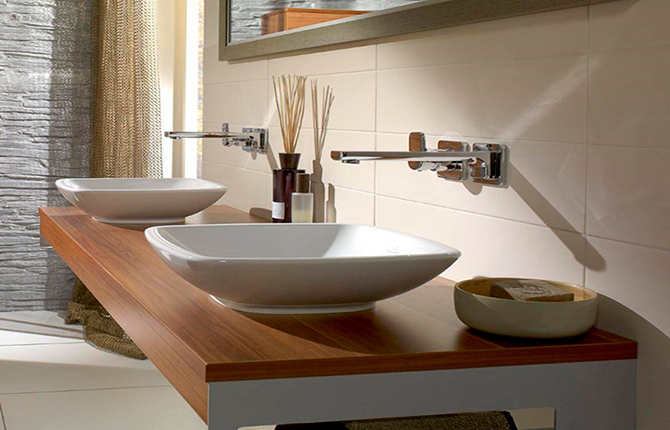
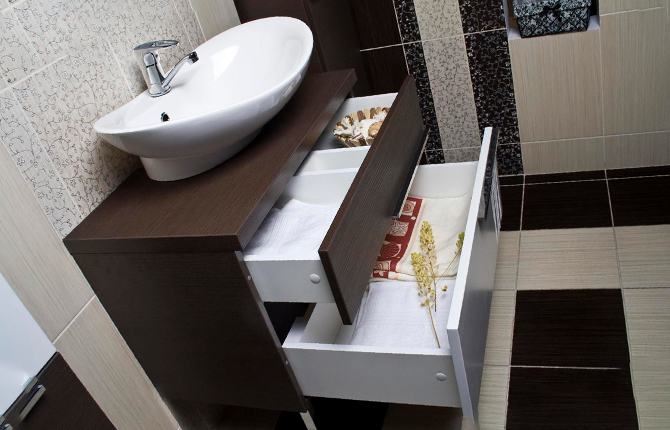
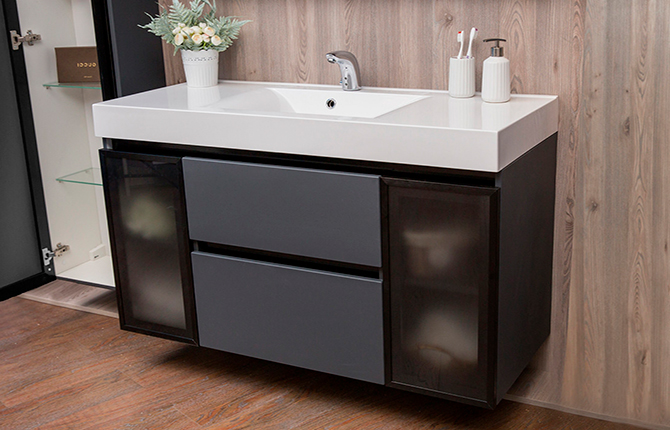





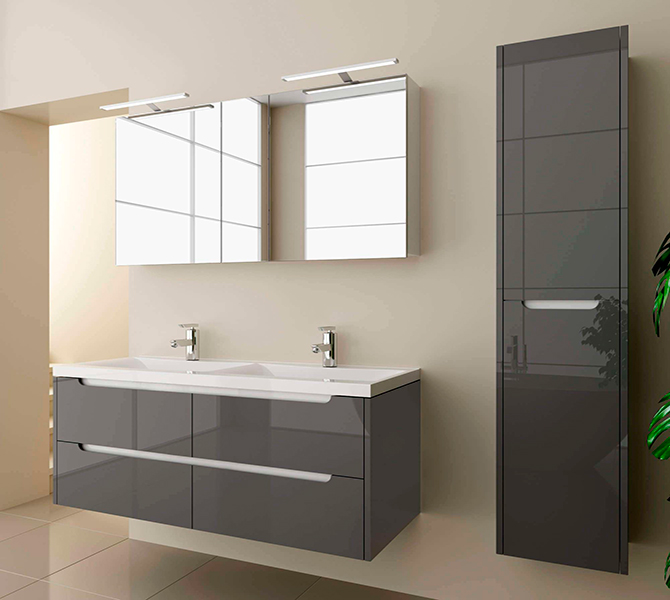







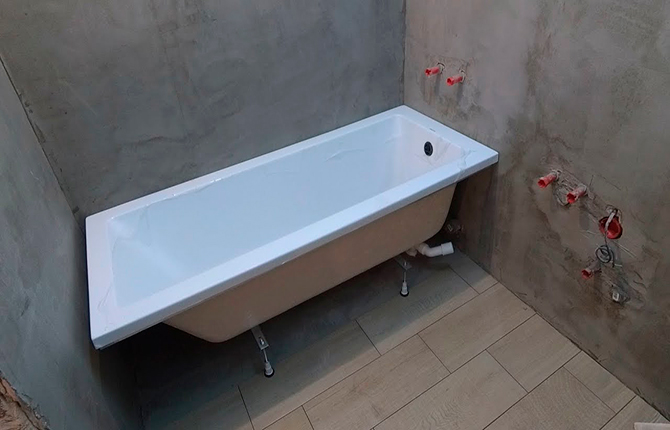








My advice is to take Italian plumbing, it’s expensive, but it’s worth it. Their technology and raw materials are simply ideal, honed for almost a hundred years, and this is the main thing. Everything that is produced under license, joint ventures, is all nonsense. Chinese porcelain and earthenware cost three times less under license and last for 10 years at most.I myself saw Italian plumbing - a washbasin, according to the mark it is almost 70 years old, there is not a single scratch or chip.
Imagine how big a bathroom you need to make to install a free-standing bathtub. You need to pour the foundation so that it is like a mirror, then run the pipes through the entire room, plus a wooden ladder. This requires 5-6 squares, no less. The plumbing is not for our apartments; it is better to install a steam room. There are more benefits, and installation is simple, without a foundation or sewerage.